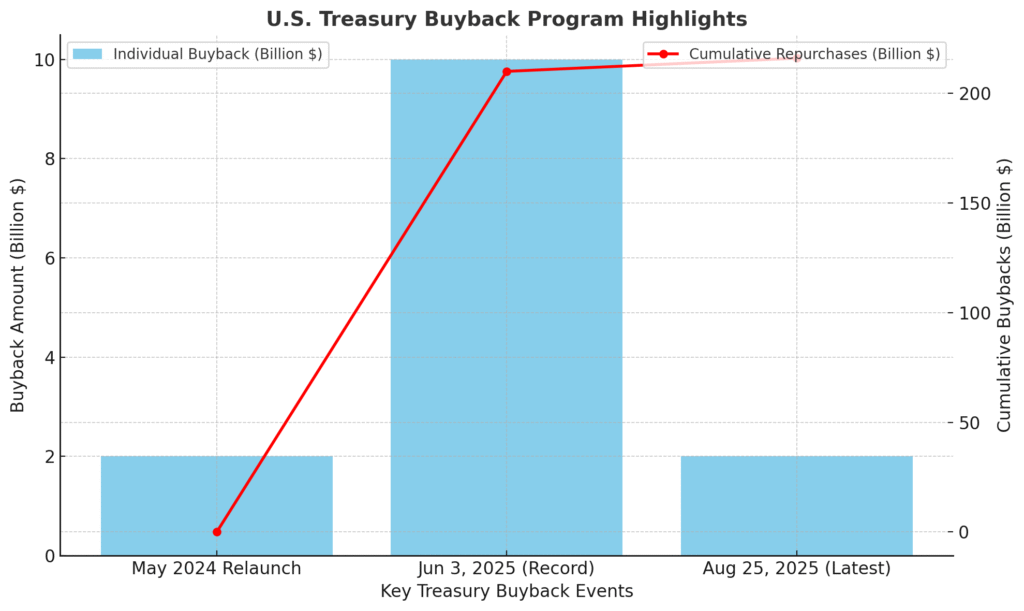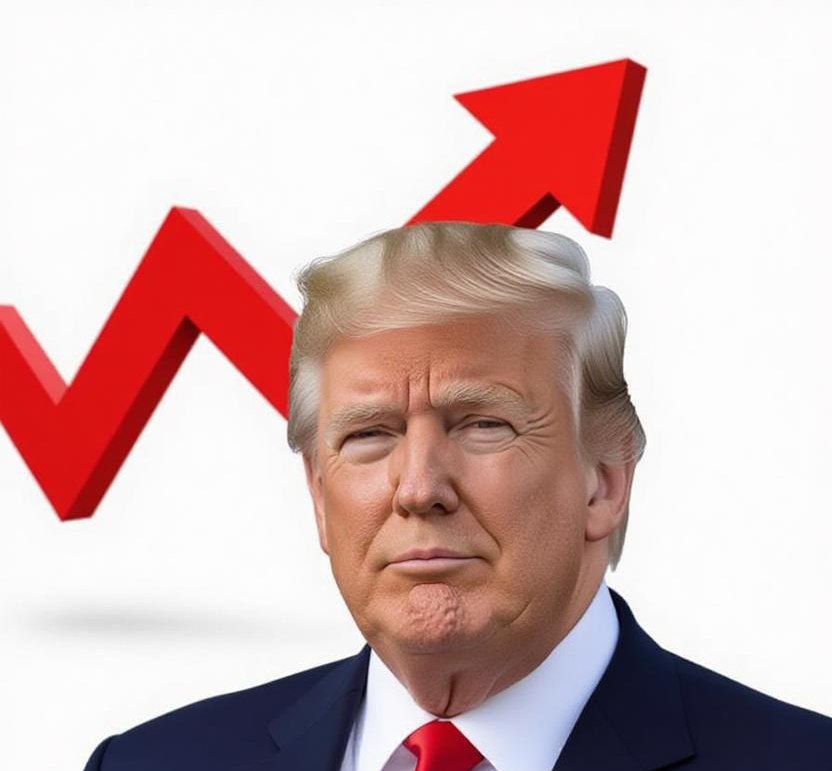The U.S. Treasury repurchased $2 billion in debt on August 25, 2025, contributing to $6 billion in buybacks last week. Learn why the buyback program was relaunched, how it impacts bond yields, equity markets, and U.S. national debt sustainability as it tops $37 trillion.
U.S. Treasury Debt Buyback: $2 Billion on August 25, $6 Billion in a Week
The U.S. Treasury has once again stepped into financial markets with a series of debt buybacks, signaling both a tactical and strategic approach to managing America’s enormous federal debt burden. On August 25, 2025, the Treasury conducted a $2 billion buyback operation, part of a cumulative $6 billion in securities repurchased over the week. This is the latest chapter in a program that has become a centerpiece of U.S. debt management since it was relaunched in May 2024.
To understand the implications of these buybacks, one must look beyond the headline figures. They are not just routine transactions; they reflect deeper concerns about rising borrowing costs, global investor sentiment, and the sustainability of the United States’ $37 trillion debt load. This article explores the context, history, mechanics, and broader implications of the buyback program, weaving together economic realities, financial market responses, and policy debates to paint a comprehensive picture of what these actions mean for investors, policymakers, and the global economy.
Overview of the Buyback
On August 25, 2025, the U.S. Department of the Treasury executed a $2 billion debt buyback. According to a post on X, this operation contributed to a total of $6 billion in securities repurchased over the week. The buyback is part of a broader debt management program that was restarted in May 2024, after more than two decades of dormancy.
The program targets off-the-run securities, which are bonds no longer being actively issued, and Treasury Inflation-Protected Securities (TIPS). These buybacks are authorized under Section 3111 of Title 31 of the United States Code and are designed to improve market liquidity, reduce volatility, and potentially lower borrowing costs by retiring older, higher-yield debt.
Key details of the latest buyback include:
- Date of operation: August 25, 2025
- Amount: $2 billion repurchased in a single transaction
- Weekly total: $6 billion repurchased over multiple operations
- Purpose: Enhance liquidity in the secondary market, stabilize market dynamics, reduce interest costs, and send a signal of proactive fiscal management
The Background: Why Buybacks Matter
The U.S. Treasury’s buyback program had been dormant since 2002. Its reintroduction in May 2024 was a notable policy shift, aimed at addressing the challenges posed by rising interest rates, heightened market volatility, and an ever-expanding federal debt.
When the Treasury first experimented with buybacks in the early 2000s, the United States was running budget surpluses, and the government used buybacks to reduce outstanding debt. Fast forward to 2024, the context could not be more different. Rather than surpluses, the U.S. is facing trillion-dollar deficits and ballooning interest costs. The buyback program today serves not as a tool of surplus management, but as a mechanism to navigate through an era of high borrowing costs and debt sustainability concerns.
The Treasury currently conducts liquidity support buybacks weekly, with caps of $2 billion per operation for nominal coupon securities and $500 million for TIPS.
Historical Precedent and Recent Escalation
The last significant buyback period was in the early 2000s. For example, in 2000, the Treasury conducted a $3 billion buyback. Those operations, however, were much smaller in scope and driven by entirely different macroeconomic conditions.
The program’s relaunch in 2024 quickly gained momentum. On June 3, 2025, the Treasury executed a $10 billion buyback, the largest in U.S. history. This represented a dramatic escalation in the scale of operations compared to the early 2000s.
Since May 2024, cumulative repurchases have exceeded $210 billion, with more than $41.5 billion injected into the market in the most recent quarter alone. This highlights the Treasury’s increasing reliance on buybacks as a central tool of debt management.
Details of the August 25 Buyback
While official details about the exact securities repurchased in the $2 billion buyback on August 25 remain limited, several insights can be drawn from the broader program and previous operations.
- Securities targeted: The focus is on off-the-run securities, which are less actively traded than newly issued Treasuries. These tend to have maturities ranging from short- to mid-term. For instance, in the June 3, 2025 operation, the Treasury repurchased bonds maturing between July 15, 2025, and May 31, 2027.
- Market participation: The August 25 operation saw $19.7 billion in bonds offered by investors, but only $2 billion were accepted by the Treasury. This selective approach underscores the Treasury’s strategic priorities, focusing only on securities that align with its objectives.
- Settlement process: Buybacks generally settle within one to two days. For example, the June 3 buyback settled the next day. This ensures rapid injection of liquidity and market impact.
- Weekly total: The $6 billion repurchased last week suggests multiple operations were conducted, consistent with the Treasury’s commitment to weekly buybacks.
Strategic Objectives of the Buyback Program
The Treasury’s buyback program serves several key objectives, each reflecting broader economic and financial realities.
- Liquidity support
By targeting less liquid securities, the Treasury helps stabilize markets. These repurchases make it easier for investors to trade U.S. government debt, thereby reducing volatility and tightening bid-ask spreads. - Debt management
Buybacks allow the Treasury to retire older securities with higher coupon payments. These can be replaced with newly issued debt at lower yields, potentially reducing overall interest costs in the long run. - Market signaling
Even relatively modest buybacks, such as the $2 billion operation on August 25, serve as signals of fiscal responsibility. They show that the Treasury is actively managing the debt profile, which can reassure investors at home and abroad. - Response to economic conditions
Rising interest rates and inflationary pressures, alongside Federal Reserve tightening, have made borrowing more expensive. Buybacks help adjust the debt portfolio to better withstand these conditions.
Market and Economic Implications
The Treasury’s buybacks have had noticeable effects across financial markets and beyond.

Bond Market Effects
The August 25 buyback contributed to a modest decline in yields. The 10-year Treasury yield slipped from 4.42% to 4.35%. This indicates reduced selling pressure and enhanced stability. Bond market volatility also eased, with the Move index falling to 80 points, its lowest level since March 2022.
Equity Market Effects
Equity markets often respond positively to buybacks, as they reduce uncertainty and stabilize financial conditions. For instance, the June 3 buyback helped lift the S&P 500 by 0.6%, with financial and utility stocks leading the gains. The $6 billion repurchase in the week of August 25 likely contributed to similar cautious optimism.
Investor Confidence
The buybacks reassure investors by demonstrating proactive debt management. This is particularly important for foreign holders of U.S. debt, such as China and Japan, who collectively own over 30% of outstanding Treasuries. Their continued confidence is critical for sustaining U.S. borrowing capacity.
Fiscal Policy Context
The buybacks are taking place amid heated debates over federal spending, taxation, and debt ceilings. With the national debt surpassing $37 trillion, and interest payments projected to reach $1 trillion annually by 2026, every measure to manage debt costs takes on heightened significance.
Federal Reserve and Fiscal Policy Interactions
The buybacks complement broader monetary policy dynamics. In June 2024, the Federal Reserve reduced the pace of quantitative tightening, lowering its monthly securities reduction from $95 billion to $60 billion. This eased selling pressure on Treasuries, aligning with the Treasury’s buyback efforts.
Together, these measures aim to balance supply and demand dynamics in Treasury markets, reducing volatility and keeping borrowing costs in check. However, they also highlight the delicate interplay between fiscal and monetary policy in an era of unprecedented debt burdens.
Broader Context: Rising Debt and Sustainability Challenges
As of August 2025, U.S. national debt has exceeded $37 trillion. If current trends continue, annual interest payments will surpass $1 trillion by 2026, rivaling defense spending and becoming one of the largest components of the federal budget.
This raises critical questions:
- Can the U.S. continue borrowing at current levels without eroding investor confidence?
- Will buybacks and other debt management tools be sufficient to mitigate rising interest costs?
- What role will fiscal reforms, such as spending cuts or tax adjustments, play in addressing long-term sustainability?
These debates are intensifying in Congress and among policymakers, investors, and economists. The buyback program, while useful, is ultimately a tactical measure within a much larger fiscal puzzle.
Conclusion: What Investors and Observers Should Watch
The Treasury’s $2 billion buyback on August 25 and the $6 billion total for the week are not isolated events. They are part of a broader strategy to navigate an increasingly complex debt landscape.
For investors, the key takeaways are:
- The Treasury is committed to weekly buybacks, signaling ongoing intervention in debt markets.
- Buybacks are helping stabilize yields and reduce volatility, but they cannot solve the underlying debt challenge.
- The sustainability of U.S. fiscal policy remains a central concern, with interest costs rising rapidly.
As the U.S. heads toward 2026 with trillion-dollar interest payments looming, the Treasury’s buyback program will remain a critical tool. But it will also serve as a barometer of fiscal health, investor confidence, and the broader trajectory of the American economy.

